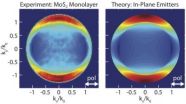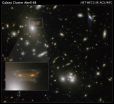(Press-News.org) PROVIDENCE, R.I. [Brown University] — A multi-university research team has used a new spectroscopic method to gain a key insight into how light is emitted from layered nanomaterials and other thin films.
The technique, called energy-momentum spectroscopy, enables researchers to look at the light emerging from a thin film and determine whether it is coming from emitters oriented along the plane of the film or from emitters oriented perpendicular to the film. Knowing the orientations of emitters could help engineers make better use of thin-film materials in optical devices like LEDs or solar cells.
The research, published online on March 3 in Nature Nanotechnology, was a collaborative effort of Brown University, Case Western Reserve University, Columbia University, and the University of California–Santa Barbara.
The new technique takes advantage of a fundamental property of thin films: interference. Interference effects can be seen in the rainbow colors visible on the surface of soap bubbles or oil slicks. Scientists can analyze how light constructively and destructively interferes at different angles to draw conclusions about the film itself — how thick it is, for example. This new technique takes that kind of analysis one step further for light-emitting thin films.
"The key difference in our technique is we're looking at the energy as well as the angle and polarization at which light is emitted," said Rashid Zia, assistant professor of engineering at Brown University and one of the study's lead authors. "We can relate these different angles to distinct orientations of emitters in the film. At some angles and polarizations, we see only the light emission from in-plane emitters, while at other angles and polarizations we see only light originating from out-of-plane emitters."
The researchers demonstrated their technique on two important thin-film materials, molybdenum disulfide (MoS2) and PTCDA. Each represents a class of materials that shows promise for optical applications. MoS2 is a two-dimensional material similar to graphene, and PTCDA is an organic semiconductor. The research showed that light emission from MoS2 occurs only from in-plane emitters. In PTCDA, light comes from two distinct species of emitters, one in-plane and one out-of-plane.
Once the orientation of the emitters is known, Zia says, it may be possible to design structured devices that maximize those directional properties. In most applications, thin-film materials are layered on top of each other. The orientations of emitters in each layer indicate whether electronic excitations are happening within each layer or across layers, and that has implications for how such a device should be configured.
"If you were making an LED using these layered materials and you knew that the electronic excitations were happening across an interface," Zia said, "then there's a specific way you want to design the structure to get all of that light out and increase its overall efficiency."
The same concept could apply to light-absorbing devices like solar cells. By understanding how the electronic excitations happen in the material, it could be possible to structure it in a way that coverts more incoming light to electricity.
"One of the exciting things about this research is how it brought together people with different expertise," Zia said. "Our group's expertise at Brown is in developing new forms of spectroscopy and studying the electronic origin of light emission. The Kymissis group at Columbia has a great deal of expertise in organic semiconductors, and the Shan group at Case Western has a great deal of expertise in layered nanomaterials. Jon Schuller, the study's first author, did a great job in bringing all this expertise together. Jon was a visiting scientist here at Brown, a postdoctoral fellow in the Energy Frontier Research Center at Columbia, and is now a professor at UCSB."
INFORMATION:
Other authors on the paper were Sinan Karaveli (Brown), Theanne Schiros (Columbia), Keliang He (Case Western), Shyuan Yang (Columbia), Ioannis Kymissis (Columbia) and Jie Shan (Case Western). Funding for the work was provided by the Air Force Office of Scientific Research, the Department of Energy, the National Science Foundation, and the Nanoelectronic Research Initiative of the Semiconductor Research Corporation.
New spectroscopy method could lead to better optical devices
2013-03-05
ELSE PRESS RELEASES FROM THIS DATE:
Shadows over data sharing
2013-03-05
In a paper about to be published in EPJ Data Science, Barbara Jasny, deputy editor for commentary at Science magazine in Washington, DC, USA, looks at the history of the debates surrounding data access during and after the human genome "war". In this context, she outlines current challenges in accessing information affecting research, particularly with regard to the social sciences, personalised medicine and sustainability.
The trouble is that most researchers do not currently share their data. This is due both to research practices and research culture. Scientists withholding ...
Herbal defluoridation of drinking water
2013-03-05
Researchers in India have developed a filter system based on a medicinal herb, which they say can quickly and easily remove "fluoride" from drinking water. The technology described in the March issue of the International Journal of Environmental Engineering uses parts of the plant Tridax procumbens as a biocarbon filter for the ion.
Drinking water can contain natural fluoride or fluoride might be added as a protective agent for teeth by water companies. However, its presence is not without controversy while in some natural drinking water levels may be above those considered ...
Kirk, Spock together: Putting emotion, logic into computational words
2013-03-05
Kirk and Spock may not need a Vulcan mind meld to share cognition: Virginia Tech Carilion Research Institute scientists have found that our cold reasoning and hot feelings may be more intimately connected than previously thought.
"We tend to believe we have rational parts, like Spock, and separate emotional parts, like Kirk. But our research suggests that's not true," said Read Montague, director of the Human Neuroimaging Laboratory at the Virginia Tech Carilion Research Institute, who led the study. "We're all a combination of logical Spock and intuitive Kirk. Cold ...
When good food goes bad
2013-03-05
MARCH 5, 2013—Baltimore, MD—The Center for Biosecurity of UPMC today released online ahead of print a new report, When Good Food Goes Bad: Strengthening the US Response to Foodborne Disease Outbreaks. The authors analyzed existing data and studies on foodborne illness outbreak response, identified emerging trends, and interviewed dozens of federal and state-level officials and experts from industry, professional organizations, academia, and relevant international organizations. The report puts forth a series of recommendations to accelerate and strengthen responses to foodborne ...
Nurse migration in North and Central America strengthening health systems
2013-03-05
International nurse migration is a multibillion-dollar global phenomenon. Historically, Mexicans and Central Americans have not played a significant part in the migration of nurses to the United States. A new report, Strengthening health systems in North and Central America: What role for migration?, sponsored by the Migration Policy Institute (MPI), seeks to draw attention to the cross-border migration in the Americas and suggests ways the migration could be managed to meet the demand for health care services in the region.
The report, co-authored by New York University ...
Gravitational lens creates cartoon of space invader
2013-03-05
The gravitational field surrounding this massive cluster of galaxies, Abell 68, acts as a natural lens in space to brighten and magnify the light coming from very distant background galaxies.
Like a fun house mirror, lensing creates a fantasy landscape of arc-like images and mirror images of background galaxies. The foreground cluster is 2 billion light-years away, and the lensed images come from galaxies far behind it.
In this photo, the image of a spiral galaxy at upper left has been stretched and mirrored into a shape similar to that of a simulated alien from the ...
EARTH: Releasing a flood of controversy on the Colorado River
2013-03-05
Alexandria, VA – As the Colorado River winds through the Colorado Plateau's soft sedimentary strata, it picks up a tremendous amount of sediment. This sediment – which once left the river's waters so muddy that Spanish explorers christened it El Rio Colorado "the reddish river" – is a vital component to the unique ecosystems of the river. However, with the construction of the Hoover and Glen Canyon dams, which trap the sediment, the once-turbid waters have become a dazzling blue-green, signaling major changes with serious implications for the health of the river's native ...
Is the iPad creative? It depends on who's buying it
2013-03-05
Encouraging consumers to feel ownership of products they haven't yet purchased can backfire because consumers tend to see themselves in the products they own, according to a new study in the Journal of Consumer Research.
"Companies assume that consumers who are made to feel ownership of a product prior to purchase will prefer it over competing products, but this can actually have the opposite effect and lead consumers to judge the product less favorably," write authors Liad Weiss and Gita V. Johar (both Columbia University).
Companies encourage us to feel a sense of ...
Product promotion: When do emotional appeals trump celebrity spokespeople?
2013-03-05
Emotional appeals could be more effective than celebrities when promoting products related to a consumer's identity, according to a new study in the Journal of Consumer Research.
"Specific emotions can help consumers strengthen their identities by providing information about how to feel a particular identity, especially when emotions are associated with distinct patterns of action. Consumers tend to choose products that bolster emotions associated with a particular identity," write authors Nicole Verrochi Coleman (University of Pittsburgh) and Patti Williams (Wharton ...
Novel small molecules used to visualize prostate cancer
2013-03-05
Two novel radiolabeled small molecules targeting prostate-specific membrane antigen (PSMA) have excellent potential for further development as diagnostic and therapeutic radiopharmaceuticals, according to research published this month in The Journal of Nuclear Medicine. The imaging agents—123I-MIP-1072 and 123I-MIP-1095—were shown to have a high sensitivity of lesion detection in bone, soft tissue and the prostate gland with minimal retention in non-target tissue.
An estimated 238,500 men will be diagnosed with prostate cancer in 2013, and 29,700 will die from the disease. ...

